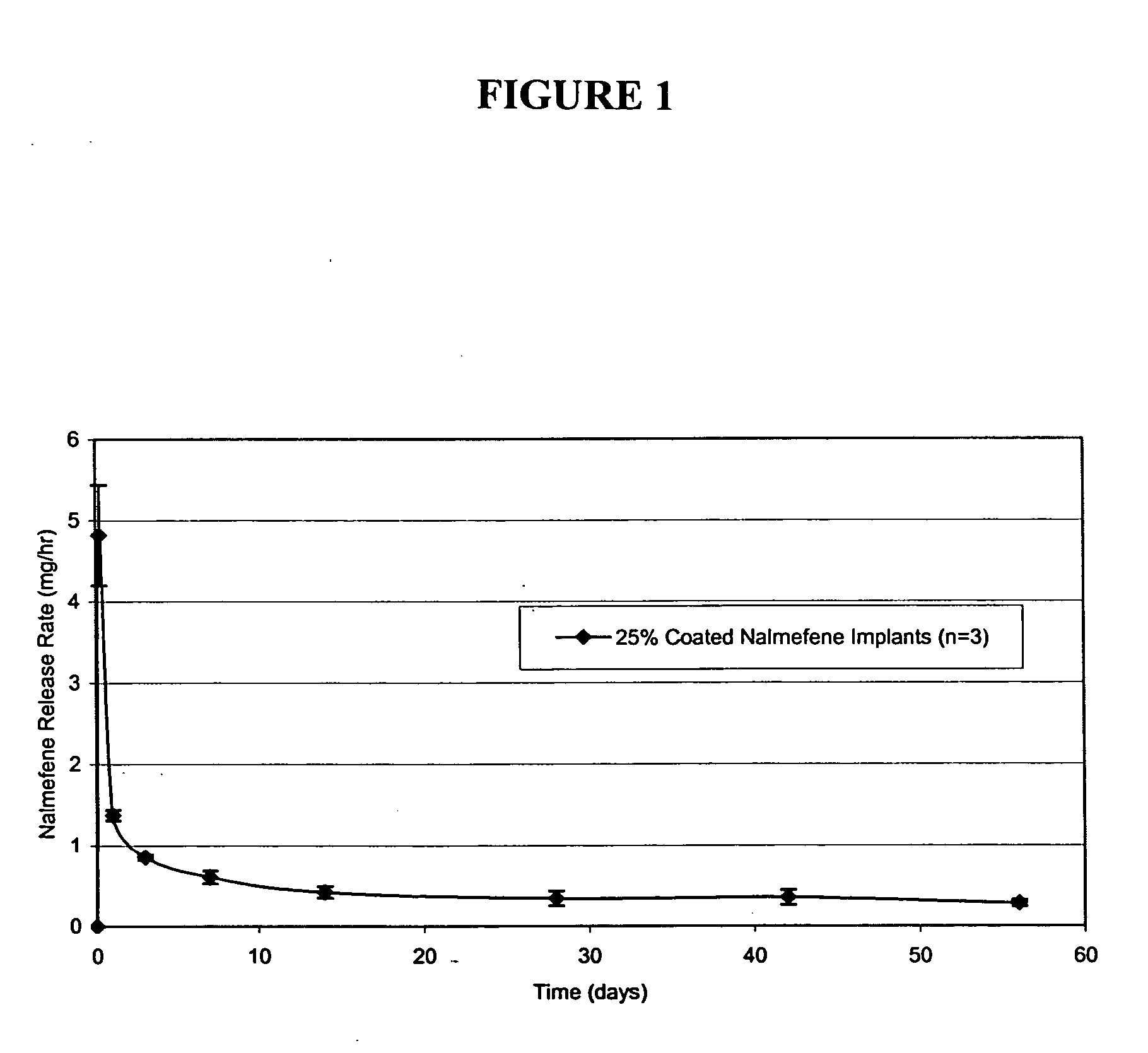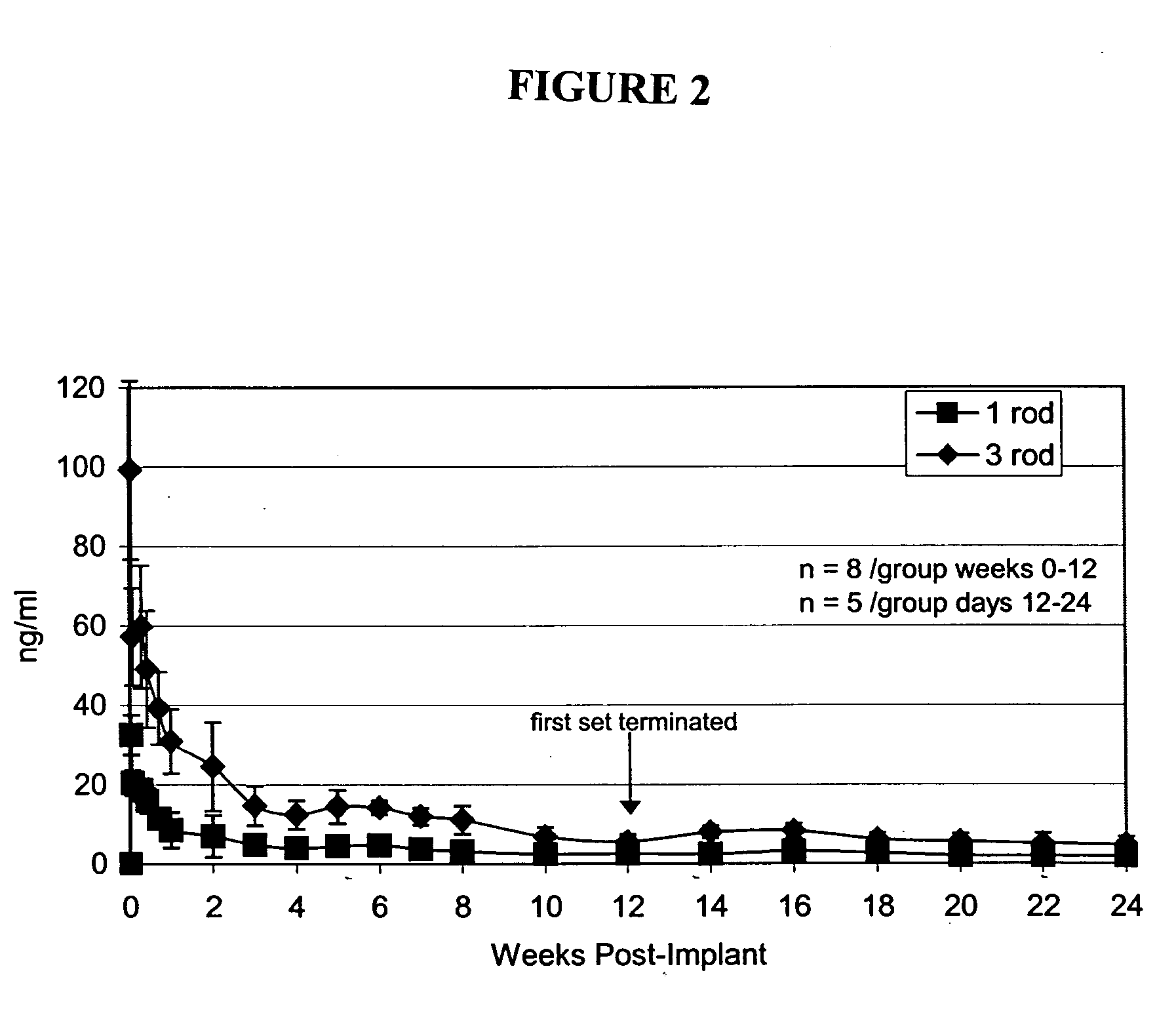Implantable polymeric device for sustained release of nalmefene
a polymer device and nalmefene technology, applied in the direction of biocide, prosthesis, drug composition, etc., can solve the problems of poor patient compliance, many return, and limited success in pharmacotherapy
- Summary
- Abstract
- Description
- Claims
- Application Information
AI Technical Summary
Benefits of technology
Problems solved by technology
Method used
Image
Examples
example 1
Preparation of Nalmefene Implants
Implantable devices were prepared using an extrusion process. Nalmefene HCl was dried at 115-118° C. under high vacuum. The final moisture content of the nalmefene was 0.3870%. Moisture content was determined by thermal gravimetric analysis (TGA). Extrusion was performed using a blend of 65% nalmefene and 35% EVA (33% vinyl acetate). The processing conditions that were used are shown in Table 1.
TABLE 1Conditions for Extrusion of Nalmefene ImplantsAugur rate˜71-72 rpmAmps˜1.36Temperatures:Zone 1˜110.5° C.Zone 2˜117.8° C.Zone 3˜110.5° C.Zone 4˜113.3° C.
The extruded fiber was cut into 27 mm implants. These implants were coated using a 0.1% solution of 33% EVA dissolved in methylene chloride using a fluid-bed coater. The coating conditions were as shown in Table 2.
TABLE 2Conditions for Spray CoatingInlet Temperature (° C.)˜32.2-33.3Outlet Temperature (° C.)˜22.2-23.3Fluidizing Air Flow˜0.80-0.75Filter Pressure (psi)˜12.5Lift Cylinder Pressure (psi...
example 2
Characterization of Extruded Implantable Devices
Extruded rods prepared as described above were characterized for total drug load and for rate of drug release.
Photomicrography
The surface and interior morphology of implants prepared as in Example 1 were examined using scanning electron microscopy (SEM). Implants were fractured cryogenically to expose the interior of the implant. Photomicrographs were taken to show one image of the microstructure of the lateral surface of the implant and one image of a cross section. From the SEM micrographs, the distribution of nalmefene and the coating looked very homogeneous.
Assessment of Drug Loading
The nalmefene content in the implants was determined by extracting the nalmefene with methylene chloride and quantitating the nalmefene using an HPLC method. The dimensions, weight, and nalmefene content of the implants is presented in Table 3.
TABLE 3Nalmefene HCl / EVA FormulationWt % (NalmefeneCompositionDimensionsHCl Content)35 / 65 Nalmefene...
example 3
In Vivo Evaluation of Nalmefene Loaded Implantable Devices
Implants were prepared by extrusion of a 30:70 blend of EVA copolymer (33% vinyl acetate) and nalmefene HCl at an elevated temperature, yielding filaments with a 2.5 mm diameter, from which 2.6 cm implants were cut. The surface of the implants was coated with an EVA suspension (14 wt % EVA in water with sodium lauryl sulfate) using a Wurster fluidized bed coater to produce a 25 wt % coating. Implants were sterilized with γ-radiation. In vitro release of nalmefene from coated and uncoated implants, both including 70% nalmefene hydrochloride, was determined by release into 100 ml of saline at 37° C., followed by HPLC analysis. The in vitro drug release from uncoated implants was 26-52 mg / day. Coating the surface of the implants with 25 wt % EVA reduced the release rate to 0.286-0.607 mg / day. Gamma sterilization of the implants had no effect on the release rates.
Wistar-derived rats were surgically implanted with either 1 (n=...
PUM
| Property | Measurement | Unit |
|---|---|---|
| Length | aaaaa | aaaaa |
| Length | aaaaa | aaaaa |
| Fraction | aaaaa | aaaaa |
Abstract
Description
Claims
Application Information
 Login to View More
Login to View More - R&D
- Intellectual Property
- Life Sciences
- Materials
- Tech Scout
- Unparalleled Data Quality
- Higher Quality Content
- 60% Fewer Hallucinations
Browse by: Latest US Patents, China's latest patents, Technical Efficacy Thesaurus, Application Domain, Technology Topic, Popular Technical Reports.
© 2025 PatSnap. All rights reserved.Legal|Privacy policy|Modern Slavery Act Transparency Statement|Sitemap|About US| Contact US: help@patsnap.com


